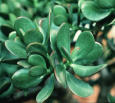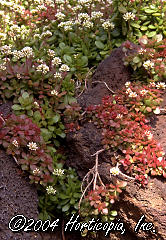Jade Plant
Crassula argentea
by Amanda Schlecht
Introduction
The Jade Plant (Crassula argentea) originated in south Africa , but has been cultivated as a house plant in Europe and America for over a hundred years. Jade plants are tough, easy-to-grow succulents. They grow well in containers and like the warm, dry conditions found in most homes. Like many succulent plants which means they have the ability to store water in its leaves, stems, and roots.
Temperature/Sun Requirements
Jade plants do best with daytime temperatures between 65 and 75 ° F, and nighttime temperatures between 50 and 55 ° F. During the winter months, protect plants from drafts and do not let their foliage touch windowpanes. Jades prefer the full sun or bright filtered light of a south-facing window. Jade plants do best where they get four or more hours a day of direct sunlight. Plants grown in sun can withstand higher temperatures than those grown in poor light.
Soil Requirements
Soil should be kept moist but not wet while plants are actively growing in spring and summer. During the winter, let the soil dry between waterings . Although the succulent look of jade plants may cause you to believe that they need very little water, drought can cause dwarfing, foliage spotting, leaf drop and death. Avoid splashing water on the leaves while watering.
Jades need a very well-drained soil mix to prevent root rot. A cactus mix with some added organic matter will do. You can also make a mix of one part sterilized organic soil, one part sphagnum peat moss and three parts coarse sand by volume.
Fertilize jade plants once every three to four months. A liquid houseplant fertilizer will work well. Wait four months before feeding repotted plants.
Jade plants can live quite happily for years while root-bound. If repotting is necessary, do it as new growth starts. When your plant becomes older and top-heavy, move it to a large, heavy pot to prevent tipping over. Allow the soil to become dry after repotting. You can start new plants from stem cuttings.
 Jade Plant as a house plant.
Jade Plant as a house plant.
HEIGHT/SPREAD
Jade plants can live for a very long time and grow into small trees or shrubs up to 5 feet tall indoors.
ORNAMENTAL FEATURES
Succulent, fleshy leaves are round or oval, dark green, blue-gray or edged in red depending on species and cultivar. The thick trunklike stems and branches of jade plants are usually brown. Clusters of star-shaped white or pink flowers will appear on mature plants in the winter. Jades look very much like miniature trees and often have an appealing bonsai quality.
 Jade plant leaflets up close.
Jade plant leaflets up close.
 Airplane Plant.
Airplane Plant.
PROBLEMS
In the home, plant diseases are very rarely a problem. Too much or too little water plus insects and mites are the main problems. Root rot usually results from a soil mix that does not drain quickly or overly frequent watering. Leaf drop can happen if the plant is allowed to become extremely dry.
Mealybugs are the most common insect pest of jade plants. They look like white puffs of cotton. Wipe them off with alcohol using a cotton swab. Do not use insecticidal soap, since it may damage jade plants. Spider mites can cause plants to lose their green color and appear dusty or speckled.
SPECIES AND CULTIVARS
Silver Jade Plant or Blue Bird Jade ( Crassula arborescens ): This jade is similar to the more frequently grown C. ovata but has blue-gray leaves with red margins. It has compact, rounded heads of pink flowers.
 Crassula arborescens.
Crassula arborescens.
Jade Tree ( Crassula ovata ): This is the most commonly grown jade plant. Stout brown trunks support succulent glossy green leaves. The flowers are starry and white.
 Crassula ovata.
Crassula ovata.
Copper Jade Tree ( Crassula ovata ‘Bronze Beauty'): This type of jade plant has small coppery green leaves on extremely slow-growing stems.
Red Jade Tree ( Crassula ovata ‘ California Red Tip'): This jade plant has purplish red edged leaves when grown in bright light to full sun.
Golden Jade Tree ( Crassula ovata ‘Sunset'): In bright light,the leaves are edged in gold. Very striking as a large specimen.
Tricolor Jade ( Crassula ovata ‘Tricolor'): This cultivar is becoming easier to find. It has creamy white-and rose-striped pointed leaves and pink and white flowers.
 Crassula pubescens radicans.
Crassula pubescens radicans.
Other Links
Home and Garden Information Center